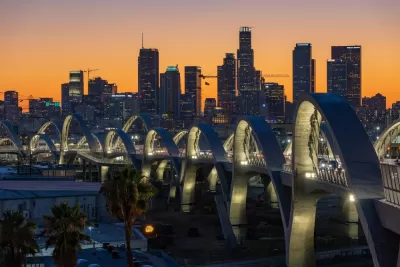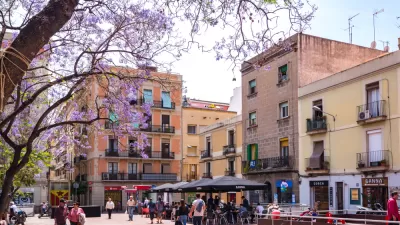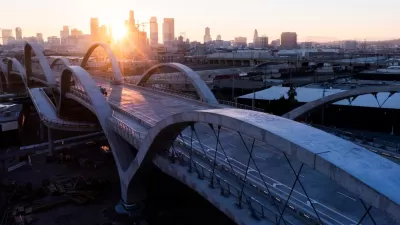Could the chaos that has plagued the 6th Street Viaduct’s first few weeks signal an opportunity to reimagine its intended uses?

Two weeks after its much-anticipated public opening, L.A.’s 6th Street Viaduct is closed. As Andy Kalmowitz reports in Jalopnik, the closure is “largely due to a near constant stream of illegal activity from drivers taking over the brand-new, $588 million bridge in downtown L.A.”
After a series of temporary closures, the city is installing speed bumps in order to discourage street racers and other reckless drivers. “Along with the new speed bumps, the city is installing a center median divider as well as fencing to discourage people from scaling the archways, which is just one more baffling thing people have been doing on the bridge.”
Even before its reconstruction, the 6th Street bridge was a famous backdrop. “The original bridge the Viaduct replaces was an iconic LA landmark, seen in movies like Grease and Terminator 2: Judgement Day. The new bridge wasted no time making a name for itself, clearly.”
The Los Angeles Times editorial board, meanwhile, recently advocated for closing the bridge to cars altogether.
The board argues that the bridge could become a West Coast version of New York City’s High Line, literally and figuratively elevating people over cars. “Despite less than ideal conditions (the speeding cars and the flimsy “protected” bicycle lanes), the 6th Street Viaduct has become a spot for family strolls, bike rides, scenic views, even quinceañera photos and a podcast recording. This is no mere roadway connecting Boyle Heights and downtown. It’s an opportunity to rethink L.A. transportation infrastructure and public space.”
FULL STORY: LA's Half-a-Billion-Dollar Bridge Shut Down After Just 2 Weeks

Planetizen Federal Action Tracker
A weekly monitor of how Trump’s orders and actions are impacting planners and planning in America.

San Francisco's School District Spent $105M To Build Affordable Housing for Teachers — And That's Just the Beginning
SFUSD joins a growing list of school districts using their land holdings to address housing affordability challenges faced by their own employees.

The Tiny, Adorable $7,000 Car Turning Japan Onto EVs
The single seat Mibot charges from a regular plug as quickly as an iPad, and is about half the price of an average EV.

Seattle's Plan for Adopting Driverless Cars
Equity, safety, accessibility and affordability are front of mind as the city prepares for robotaxis and other autonomous vehicles.

As Trump Phases Out FEMA, Is It Time to Flee the Floodplains?
With less federal funding available for disaster relief efforts, the need to relocate at-risk communities is more urgent than ever.

With Protected Lanes, 460% More People Commute by Bike
For those needing more ammo, more data proving what we already knew is here.
Urban Design for Planners 1: Software Tools
This six-course series explores essential urban design concepts using open source software and equips planners with the tools they need to participate fully in the urban design process.
Planning for Universal Design
Learn the tools for implementing Universal Design in planning regulations.
Smith Gee Studio
City of Charlotte
City of Camden Redevelopment Agency
City of Astoria
Transportation Research & Education Center (TREC) at Portland State University
US High Speed Rail Association
City of Camden Redevelopment Agency
Municipality of Princeton (NJ)





























